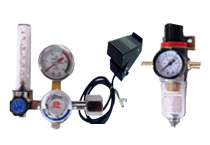
Spot Welding - 3 Easy Steps To Success
Spot welding is the method by which a spot can be melted and welded in a material in a very short period of time. This will not affect the other portion of the material. So it requires concentrated energy to a spot that it is welded. The heat for welding is got from resistance to electric current flow. The material is placed together under pressure exerted by electrodes. The sheets are about 0.5 to 3.0 mm. in thickness. Copper alloy electrodes are used to weld two sheets together in a spot. The heat that is obtained is determined by the resistance to the electrodes and the amplitude and duration of the current. If too much or too little energy is used you will not get the desired result.
There are three steps in spot welding.
In the first step the electrodes and brought to the surface of the metal and a little pressure is applied to it.
The second step is when the current from the electrodes is applied for a brief period of time.
The third step is when the current is removed and the electrodes are left in place so that the material can cool.
According to the material and its thickness, the electrode force and the diameter of the electrodes, the weld time ranges from 0.01 seconds to 0.63 seconds. To do spot welding you need tool holders and electrodes. The general types of tool holding methods are - paddle type, light duty, universal and regular off-set. The electrodes come in different shapes and sizes according to different requirements and are generally made of copper or other low resistance alloy. The work of the tool holders is to hold the electrodes in place and also keep hold water hoses in some cases to cool the electrodes while welding.
The two materials that are welded in spot welding are known as workpieces. They must conduct electricity. When the current is removed from the workpiece, the coolant holes in the center of the electrodes cool it. Water or brine solution is generally used as a coolant.
Spot welding is used for many different types of applications. It is used in different types of metal sheets. You can see it in buckets. Aluminum alloys can be spot welded using powerful and large welding transformers. It is greatly used in the automobile industry. Here the sheet metal is welded to make a car. The work can be completely automated by using robots. It is also used by orthodontists. They use a small scale spot welding equipment to resize metal molar bands. It is used to make batteries - nickel-cadmium and nickel metal hydride. The battery cells are joined by spot welding. Thin nickel straps are joined battery terminals. If soldering were done, the batteries might get too hot, while this will not happen in spot welding.
Care should be taken to see that the surfaces that have to be welded are free of oil and dust. The spot that has to be welded should be easily accessible and therefore importance should be given to the design of the material that has to be welded.
Safety measures should be followed while spot welding, since there will be a large amount of current and heat. Be sure to clamp the electrodes tightly. The hands should be protected from the severe heat given out while welding. The eyes should be protected from the intense light that is given out during the welding process.
If you plan and have all the necessary material ready for spot welding and take the necessary precautions before, during and after welding is done, you will be able to do it without difficulty.






